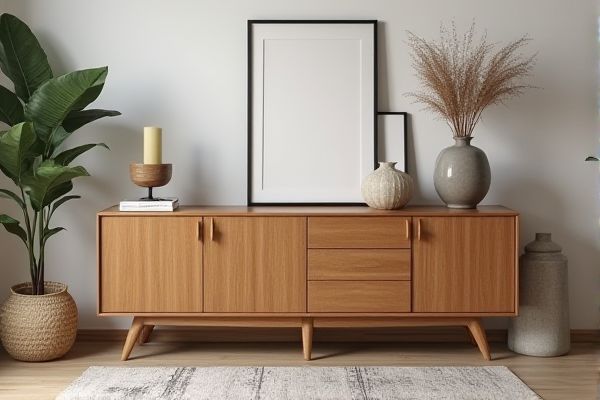
A sideboard typically features a combination of cabinets and drawers designed for storage in dining rooms, while a buffet often emphasizes countertop space for serving food during gatherings. Explore the rest of the article to discover which piece best suits Your dining area and lifestyle.
Table of Comparison
| Feature | Sideboard | Buffet |
|---|---|---|
| Primary Use | Storage and display in dining or living areas | Serving food, storage during meals |
| Design | Low-profile with cabinets and drawers | Long, low cabinet often with countertop space |
| Functionality | Holds dinnerware, linens, decorative items | Used for serving meals, storing dishes and utensils |
| Placement | Against a wall in dining or living rooms | Usually in dining room, near serving area |
| Height | Generally lower than a buffet | Typically higher with a wider surface area |
Introduction: Understanding Sideboards and Buffets
Sideboards and buffets serve as versatile storage solutions in dining rooms, designed to hold dishes, cutlery, and linens while providing a surface for serving food. Sideboards typically feature a combination of drawers and cabinets with a sleek, streamlined design, ideal for organizing smaller items. Buffets often offer larger storage spaces and a more substantial build, perfect for hosting gatherings and displaying decorative pieces, enhancing both functionality and style in Your dining area.
Historical Origins of Sideboards and Buffets
Sideboards and buffets originated in European dining traditions during the 18th and 19th centuries, serving as essential furniture pieces for storing dining essentials and displaying fine china. Sideboards, often featuring cupboards and drawers, were primarily used in formal dining rooms for serving food and storing silverware. Buffets evolved as lower, longer surfaces designed for laying out meals and drinks during social gatherings, emphasizing both function and decorative appeal in period homes.
Key Design Differences between Sideboards and Buffets
Sideboards typically feature a combination of cabinets and drawers designed for versatile storage, often with a slimmer profile suitable for dining rooms, while buffets usually have a broader, more substantial build emphasizing serving space and larger cabinet sections. The primary design difference lies in the sideboard's focus on organized storage for smaller items like silverware and linens, whereas buffets prioritize surface area for buffet-style meals and display. Your choice hinges on whether you need practical storage solutions or an expansive serving station for entertaining.
Functional Uses in Modern Homes
Sideboards often serve as versatile storage units for dining essentials like dishes, linens, and silverware, enhancing organization in modern homes. Buffets typically combine storage with a serving surface, ideal for entertaining by providing space for food presentation during gatherings. Both pieces contribute to efficient space utilization, blending functionality with style in contemporary interior design.
Materials and Styles Comparison
Sideboards and buffets are crafted from a variety of materials including solid wood, veneer, metal, and glass, each offering different durability and aesthetic appeal. Styles range from classic and rustic designs in oak or walnut to modern, sleek lines with metal or lacquer finishes, catering to diverse interior themes. Your choice between a sideboard or buffet should consider material longevity, style coherence with existing decor, and functional needs for storage or display.
Placement: Where to Use Sideboards vs. Buffets
Sideboards are typically placed in dining rooms or living areas where they serve as versatile storage for dishes, glassware, and linens, often positioned against a wall near the dining table for easy access during meals. Buffets are larger and designed for buffet-style serving, commonly located in dining rooms or open-plan spaces to provide a surface for serving food and storing dining essentials. Your choice depends on the available space and functional needs, with sideboards fitting well in smaller areas while buffets suit larger settings requiring more serving and storage capacity.
Storage Capacity and Organization
Sideboards typically offer ample storage capacity with a combination of drawers and cabinets, ideal for organizing dining essentials, linens, and servingware in a compact space. Buffets often feature larger, more open storage areas with sliding doors or open shelves, providing versatile organization options for bulkier items like platters and glassware. Your choice depends on whether you prioritize a structured storage system or open display and easy access for entertaining.
Decorating Tips for Sideboards and Buffets
Sideboards and buffets enhance dining room decor by offering both storage and display space for decorative items like vases, candles, and framed photos. Choose a sideboard with sleek lines and metallic accents for a modern look, or a buffet with rustic wood and distressed finishes to add warmth and texture. Arrange decor in varying heights and incorporate functional elements like trays and bowls to balance aesthetics and utility.
Sideboard vs Buffet: Pros and Cons
A sideboard typically offers more enclosed storage with drawers and cabinets, ideal for organizing dining essentials, while a buffet often provides open shelves or a combination of storage options, enhancing display flexibility. Sideboards excel in compact spaces due to their streamlined design, whereas buffets can accommodate larger items and serve as a multifunctional surface for serving or decor. However, sideboards may lack open display areas, and buffets can require more floor space, impacting room layout and accessibility.
How to Choose the Right Piece for Your Space
When choosing between a sideboard and a buffet, consider the function and size of your space; sideboards typically have enclosed storage ideal for dining essentials and smaller spaces, while buffets often provide open shelving or drawers suited for larger storage needs and serving areas. Measure the available wall space carefully to ensure the piece fits comfortably without overwhelming the room, and assess your storage requirements, such as whether you need more drawer or cabinet space. Select a style and finish that complements your existing decor, enhancing both functionality and aesthetic appeal in your dining or living area.
 homyna.com
homyna.com